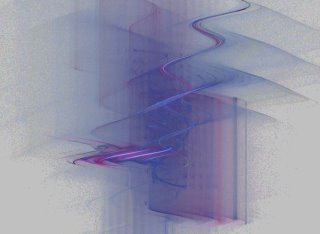Playing Full Card Bingo
"Chaos is a friend of mine." - Bob Dylan
"Our real discoveries come from chaos, from going to the place that looks wrong and stupid and foolish." - Chuck Palahniuk.
"You must have chaos within you to give birth to a dancing star." - Friedrich Nietzsche.

Pretend you're playing a full-card game of bingo with me. You have several cards in front of you, and I have several in front of me, as do other players in the hall. They are printed on low-quality, newspaper-like paper, and we have ink-daubers which we use to cover a number on our cards when it is called out by the caller. As we ink the numbers called, the ink bleeds a little bit around the edges, forming a circle, but under magnification there is much turbulence in the circular line that we see superficially with the naked eye. This area of turbulence in a transition phase is an area of great interest, study and concern to Chaos Theorists, but we're playing bingo, so we don't much care about it.
We are randomly filling in our various cards as numbers are called, depending upon whether or not the numbers match those printed on our cards, and where they are printed. Imagine that, as we place our 'existence dots' on the surface of who we are, at some point we each have but one number uncovered, and it is the same number on both our cards. Assume the caller calls it out. Simultaneously, and working from a different sequence of events, we arrived at the same level of completeness...our cards were full of dots (I am a dot, a seed with the characteristics described by the five tenets of 'is'), it was the same value that filled them, and we were declared joint winners. Neither of us got there first, but we took different routes in filling our 'life-page', just as we took different routes arriving at this blog entry.
This is a metaphor for some major components of both the Chaos Theory and the 'is' theory. Both ends towards the middle, a meeting of the minds. Opposite attract. The broken circle becomes a closed system. Transition thresholds, areas of turbulence. Patterns within patterns. Mirror-image approaches. Placing the reader's conscious mind half an inch above the page of a book, while the author's is placed half an inch below the page. The turbulence of difference of thought in that imagined inch of space is the threshold of learning and teaching, the communicating that is going on between the author and the reader, the talker and the listener. Crossing over that space to the other side is a measure of growth, of transition, of understanding or of study. It applies in areas as diverse as studying star clusters to predicting the price of wool; from analyzing the tides of the Nile river to a butterfly's beating wings in Tokyo having an effect on the weather patterns in London England. Chaos Theory addresses all this, and so does 'is'. For example, if the clustering of stars or the great red spot on the planet Jupiter are of scientific interest to meteorologists and astronomers, why should't the clustering of letters within words be of significant interest to a linguist or historian? Is the similarity found in the spelling of 'chance' and 'chaos' just chance, or could it be part of a predictable chaotic language pattern? My theory of 'is' predicts the latter.
Last night, I was flying to Edmonton from Ottawa. At 35,000 feet somewhere over Canada between those two cities, (I imagined it to be over my birth place of Sault Ste. Marie Ontario), I turned a page near the middle in the book I was reading called "Chaos: A New Science", and there staring at me in bold print was the title of the next chapter : Universality. That was a crossover point for me. Physically, I'm positioned in space 35,000 feet above the earth-point where in 1966 I wrote about a six-page proof for my Grade 13 Trigonometry teacher, Mr. Benoit, demonstrating that the asymptotic curve of the tangent function, if plotted on the surface of a cylinder of infinite diameter would be a smooth spiral with a period of 360 degrees.
He encouraged us by challenging us to think about topics way outside the range of the standard curriculum that we would be tested on with provincially standardized tests. The understanding was always that we would get a grade of zero or 5 on these papers; we either got it right thus earning us 5 bonus course marks, or we didn't. To the best of my recollection, I was the only student to accept his challenge, and I only did it the once. I remember spending endless hours working through that proof, I remember how proud I was to have thought of something no one had thought of before, and I remember also how proud I was when he handed it back a week or two later with the carefully scribed words in the bottom right corner of the last page "Nice effort!" followed by a zero, which he had also carefully circled. There was no other comment or feedback, but I didn't need it...I had accomplished my goal (and, as a teacher myself later, I came to understand that he had accomplished his which was to motivate me;...he is, was and will remain one of the most influential mentors of my life). I know I kept that paper for years...I'm hoping it's still buried in the bowels of my crawl space collectibles that I've been sifting through these past few weeks.
I was writing that paper at age 18 for a high school teacher at about the same time as people like Mandlebrot and May, Yorke, Sarkovskii and Koch were working independently on puzzling aspects that intrigued them and eventually fused themselves together to form the history and basic mosaic of Chaos Theory. As I read the story behind their work, and the evolution of fractals and Cantor Dust, the Koch Snowflake and the Sierpinski Carpet and the Meger Sponge, I'm fascinated by the common threads that drove all these men. They pursued counter-intuitive thinking, often finding themselves at odds with current trends in the scientific world of research and study, meeting each other and each other's work by happenstance and accident as often as by design or intention.
At that moment last night in the airplane, I found convergence in my life. If, as I said in last week's blog, I felt emboldened then, now I feel empowered. It seems my theory of 'is' with it's proposed universal patterning in areas both scientific and non-scientific, had been evolving through my peculiar way of seeing and analyzing the world around me; the fact that I was flying home from a trip whose purpose had been for my brother to finalize the accounting and bureaucratic governmental tax requirements of the 'independent businessman' phase of my life, giving it closure and finality, opening room for an ensuing phase; the fact that I was staring at the word 'Universal' from the chaos bingo card, as I filled in my last dot from the 'is' side of the page; the evolving understanding that my intuitive approach to the issue is not unlike that of the recognized scientists in the field; the awareness that my theory is a logical extension of theirs, just as theirs is a necessary fundamental of mine. The entire process, with endless more details and example than I care to elaborate here, from Koch'es infinite line bounded by finite space, to black holes increasing in mass as they decrease in volume, to Einstein's theory of relativity....it all fell into place at that one point of convergence. I sat suspended above the town where I wrote the paper starting the mental journey which has taken me 40 years of personal growth and evolution, several career changes, many mental ponderings in perception both through intellectual growth and setback, as well as through mental changes such as depressions, hypomanic states, and mania, each one fitting the patterns of both theories.... areas of turbulence at thresholds of change.
That epiphany in the dark skies over Canada on April 17th 2006 marks the starting point of the next level of my life's existence. It will be focussed on the coalescing of the 'data' that I have accumulated for near on 58 years now. My intention is that it will take the form of a book, fully understanding that future circumstance, unpredictable by either theory, might alter that. It's all a case of filling the card with dots. The pattern often appears random even though it's not, just as with the two bingo cards, it's all relative to the point of view from which it is observed. In the bingo game, you and I became simultaneous 'winners' or completers. From the point of view of the other gamers in the room, they perceived our completeness as something totally different.

"I've learned that the greatest risk is in thinking too small." -Age 61
.....but I've also simultaneously learned that the risk is only great if the thinking is limited to smallness. It's equally great if it excludes small thinking.
I've been consistently advocating PEACE on my blogs, and have had daily peace links to sites representing various aspects on the theme. But that has only been a piece of the peace picture. I am still, and will always advocate PEACE as a deferential and preferential goal state, but I'm learning to understand that it can only exist simultaneously in the presence of the turbulence which defines the crossovers or thresholds between personal peace states and external peace states, whether they be community, global or universal. It's the same problem in each case, with the variable being one of scale. Although scale can change linearly according to the laws of Euclidean geometry, the predictably of consequence assumes a different pattern than the intuitively-obvious one at the various threshold points (i.e. in physical sciences, factors such as friction, inertia, gravitational pull, magnetic fields etc.). In the past, the differences at contact points of phases have often been considered so negligible as to be inconsequential. That was the great misunderstanding and false assumption. That is why there are pearls of wisdom spoken such as "the greatest plans of war are rendered useless once the enemy becomes engaged." That doesn't have to be a truism if the plans went but one step further to include the engagement of the enemy.
It is those crossover points (change states, turbulence patterns, fractal laws) that are capturing my interest and focus. They are the key to completing, and therefore unlocking, the biggest secrets we know of today. The excitement comes though, not from uncovering these secrets and solving these mysteries, not from getting a grade of 5 on a paper, but knowing that by doing so, only one more level has been determined and inevitably either a more complex or a trivially more simplistic level ---- in either case, a more mysterious level ----- lies yet beyond that; except it is unpredictably so because of the chaotic nature of the patterns. It is sublimely beautiful to ponder, and gratifyingly complete to begin to grasp.












This is very good post! I found another bingo related website with good info
Posted by Anonymous |
4:52 a.m.
Anonymous |
4:52 a.m.
Post a Comment